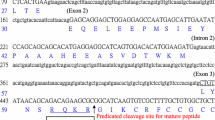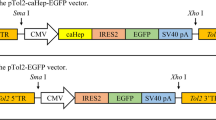Abstract
Hepcidin is a cysteine-rich, dual-function peptide with antimicrobial activity that plays a crucial role in iron homeostasis. Here, we have identified two hepcidin-like cDNA sequences from pigeon, Columba livia. The two cDNAs consist of 295 and 380 nucleotides, respectively, and were named HP1 and HP2. Sequence alignment showed that the homology between pigeon and mammals or amphibians is higher than that of pigeon and fishes. Semi-quantitative RT-PCR analysis suggested that HP1 transcripts are highly abundant in liver, abundant in spleen, less abundant in kidney and muscle, and undetectable in brain and intestine. However, HP2 are strongly expressed in the liver, spleen, kidney and muscle, weakly in the intestine, and not in the brain. After pigeon were submitted either to lipopolysaccharide (LPS) infection or iron-dextran stimulation, the hepcidin transcript levels were analyzed by a comparative RT-PCR. The results revealed that the expression of hepatic HP1 dramatically increased at 6 h post-infection of LPS injection, then gradually declined to normal levels. HP1 mRNA in the liver was 4.5–5-fold increase compared with the control animals after one week in iron-dextran injection pigeons. Interestingly, liver HP2 expression was only significant increase in the LPS infection pigeons, and not statistical change in iron-dextran stimulation ones. All these results indicate that the two hepcidins-like may have different functions in pigeon.





Similar content being viewed by others
References
Krause A, Neitz S, Magert HJ et al (2000) LEAP-1, a novel highly disulfide bonded human peptide, exhibits antimicrobial activity. FEBS Lett 480:147–150
Park CH, Valore EV, Waring AJ et al (2001) Hepcidin, a urinary antimicrobial peptide synthesized in the liver. J Biol Chem 276:7806–7810
Ganz T (2003) Hepcidin, a key regulator of iron metabolism and mediator of anemia of inflammation. Blood 102:783–788
Douglas SE, Gallant JW, Liebscher RS et al (2003) Identification and expression analysis of hepcidin-like antimicrobial peptides in bony fish. Dev Comp Immunol 27:589–601
Shi JS, Alvin CC (2006) Hepcidins in amphibians and fishes: antimicrobial peptides or iron-regulatory hormones? Dev Comp Immunol 30:746–755
Shike H, Lauth X, Westerman ME et al (2002) Bass hepcidin is a novel antimicrobial peptide induced by bacterial challenge. Eur J Biochem 269:2232–2237
Rodrigues PN, Vazquez-Dorado S, Neves JV et al (2006) Dual function of fish hepcidin: response to experimental iron overload and bacterial infection in sea bass (Dicentrarchus labrax). Dev Comp Immunol 30:1156–1167
Nemeth E, Rivera S, Gabayan V et al (2004) IL-6 mediates hypoferremia of inflammation by inducing the synthesis of the iron regulatory hormone hepcidin. J Clin Invest 113:1271–1276
Shike H, Shimizu C, Lauth X et al (2004) Organization and expression analysis of the zebrafish hepcidin gene, an antimicrobial peptide gene conserved among vertebrates. Dev Comp Immunol 28:747–754
Lauth X, Babon JJ, Stannards JA et al (2005) Bass hepcidin synthesis, solution structure, antimicrobial activities and synergism, and in vivo hepatic response to bacterial infections. J Biol Chem 280:9272–9282
Pigeon C, Ilyin G, Courselaud B et al (2001) A new mouse liver-specific gene, encoding a protein homologous to human antimicrobial peptide hepcidin, is over-expressed during iron overload. J Biol Chem 276:7811–7819
Nicolas G, Bennoun M, Devaux I et al (2001) Lack of hepcidin gene expression and severe tissue iron overload in upstream stimulatory factor 2 (USF2) knockout mice. Proc Natl Acad Sci USA 98:8780–8785
Roetto A, Papanikolaou G, Politou M et al (2003) Mutant antimicrobial peptide hepcidin is associated with severe juvenile hemochromatosis. Nat Genet 33:21–22
Fraenkel PG, Traver D, Donovan A et al (2005) Ferroportin1 is required for normal iron cycling in zebrafish. J Clin Invest 115:1532–1541
Xiao DS, Jiang L, Che LL et al (2003) Nitric oxide and iron metabolism in exercised rat with l-arginine supplementation. Mol Cell Biochem 252:65–72
Roecker L, Meier R, Brechtel L et al (2005) Iron-regulatory protein hepcidin is increased in female athletes after a marathon. Eur J Appl Physiol 95:569–571
Xiao DS, Qian ZM (2000) Plasma nitric oxide and iron concentrations in exercised rats are negatively correlated. Mol Cell Biochem 208:163–166
Liu YQ, Duan XL, Chang YZ et al (2006) Molecular analysis of increased iron status in moderately exercised rats. Mol Cell Biochem 282:117–123
Nemeth E, Valore EV, Territo M et al (2003) Hepcidin, a putative mediator of anaemia of inflammation, is a type II acute-phase protein. Blood 101:2461–2463
Chen SL, Xu MY, Ji XS et al (2005) Cloning, characterization, and expression analysis of hepcidin gene from red sea bream (Chrysophrys major). Antimicrob Agents Ch 49:1608–1612
Chang YZ, Qian ZM, Wang K et al (2005) Effects of development and iron status on ceruloplasmin expression in rat brain. J Cell Physiol 204:623–631
Altschul SF, Gish W, Miller W et al (1990) Basic local alignment search tool. J Mol Biol 215:403–410
Gish W, States DJ (1993) Identification of protein coding regions by database similarity search. Nat Genet 3:266–272
Zhang J, Madden TL (1997) Power BLAST: a new network BLAST application for interactive or automated sequence analysis and annotation. Genome Res 7:649–656
Thompson J, Gibson T, Plewniak F et al (1997) The CLUSTAL_X windows interface: flexible strategies for multiple sequence alignment aided by quality analysis tools. Nucleic Acids Res 25:4876–4882
Sun PM, Bao ED, Wang ZL (2006) Establishment and improvement on fluorescence quantitative PCR of HSP-(70) mRNA in the broilers. Agr Biotech 14:45–50
Hirono I, Hwang JY, Ono Y et al (2005) Two different types of hepcidins from the Japanese flounder Paralichthys olivaceus. FEBS J 272:5257–5264
Nemeth E, Valore EV, Territo M et al (2003) Hepcidin, a putative mediator of anemia of inflammation, is a type II acute-phase protein. Blood 101:2461–2463
Diamond G, Russell JP, Bevins CL (1996) Inducible expression of an antibiotic peptide gene in lipopolysaccharide-challenged tracheal epithelial cells. Proc Natl Acad Sci USA 93:5156–5160
Diamond G, Kaiser V, Rhodes J et al (2000) Transcriptional regulation of β-defensin gene expression in tracheal epithelial cells. Infect Immun 68:113–119
Bals R, Wang X, Meegalla RL et al (1999) Mouse β-Defensin 3 is an inducible antimicrobial peptide expressed in the epithelia of multiple organs. Infect Immun 67:3542–3547
Sanga YM, Balaji R, Mintonb JE et al (2006) Porcine liver-expressed antimicrobial peptides, hepcidin and LEAP-2: cloning and induction by bacterial infection. Dev Comp Immunol 30:357–366
Chen SL, Li W, Meng L et al (2007) Molecular cloning and expression analysis of a hepcidin antimicrobial peptide gene from turbot (Scophthalmus maximus). Fish Shellfish Immunol 22:172–181
Detivaud L, Nemeth E, Boudjema K et al (2005) Hepcidin levels in humans are correlated with hepatic iron stores, hemoglobin levels, and hepatic function. Blood 106:746–748
Pedro NSR, Sandra VD, Joao VN et al (2006) Dual function of fish hepcidin: Response to experimental iron overload and bacterial infection in sea bass (Dicentrarchus labrax). Dev Comp Immunol 30:1156–1167
Bao B, Peatman E, Li P et al (2005) Catfish hepcidin gene is expressed in a wide range of tissues and exhibits tissuespecific up-regulation after bacterial infection. Dev Comp Immunol 29:939–950
Acknowledgments
We are grateful to Dr. Wen Qiang Li for technical assistance, to Dr. Li Gao for helpful advices to the manuscript. We appreciate two anonymous reviewers for the revision. This work was supported by a grant from Natural Science Foundation of China (No. 30570957).
Author information
Authors and Affiliations
Corresponding authors
Additional information
Yu Ming Fu and Su Ping Li contributed equally to this work.
Rights and permissions
About this article
Cite this article
Fu, Y.M., Li, S.P., Wu, Y.F. et al. Identification and expression analysis of hepcidin-like cDNAs from pigeon (Columba livia). Mol Cell Biochem 305, 191–197 (2007). https://doi.org/10.1007/s11010-007-9543-1
Received:
Accepted:
Published:
Issue Date:
DOI: https://doi.org/10.1007/s11010-007-9543-1




